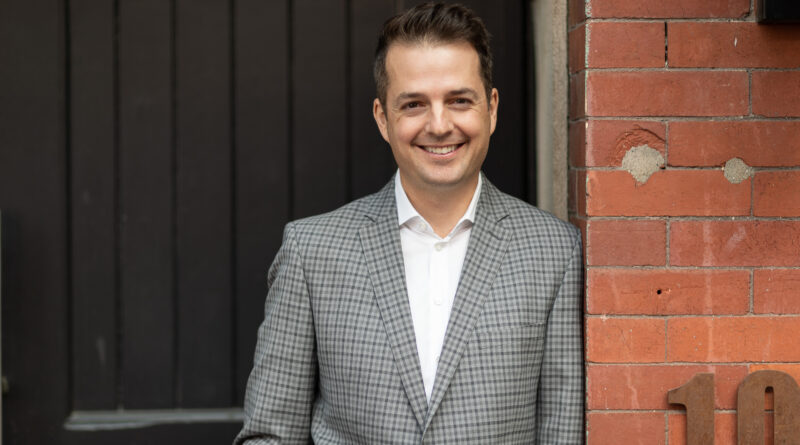Interview Todd Talbot on his new project ‘Todd Talbot Builds: The Passive House Project’
Todd Talbot, beloved real estate expert from Love It or List It Vancouver, embarks on a new adventure with his series Todd Talbot Builds: The Passive House Project, premiering October 8 on Cottage Life. This eight-part documentary follows Todd and his wife, actor Rabecca Talbot, as they construct a sustainable, net-zero passive house on the shores of Okanagan Lake, B.C. Throughout the show, Todd emphasizes the importance of building resilient homes, a theme brought to the forefront when the family’s nearly completed passive house was tragically lost to wildfires during British Columbia’s record-breaking 2023 wildfire season. The series captures their emotional journey, from the project’s hopeful inception to its devastating end, underscoring the need for sustainable, wildfire-resistant homes in the face of climate change.
The Extra Mile interviews, Todd Talbot who opens up about the challenges of building a passive house, the resilience of sustainable homes, and how this personal project has shifted his perspective on construction and environmental responsibility.
TEM (The Extra Mile) : Can you explain the core principles of passive house building for those who might not be familiar?
Todd: Which is most people, including myself when I started down this path a number of years ago. Basically, passive house construction is a kind of scientific model that follows a few principles to try and make a home super energy efficient and more resilient and healthier space to live. So it’s trying to move the building industry forward embracing some newer technology and building styles. So basically Passive house has five core principles to it. So super insulated, high-performance windows and doors, super airtight, and HRB system, which is the lungs of the building so that the building can breathe. We can have fresh air and no thermal bridging, which is essentially stopping construction. production materials bridging from the outside to the inside. So that is, it’s relatively straightforward. It’s just that the building industry hasn’t quite embraced this. It’s definitely getting more and more popular. And the building code is going to push us in that direction over the coming years. So it’s something that we’re gonna all embrace. And it’s super important because of our changing climate. And we need to make sure that our houses are safe and can protect us.
TEM: What kind of made you initially to go to the Passive house route rather than just like regular building route? Like, what does that mean to you personally?
Todd: Well, honestly, the initial motivation for it was to try and be a little bit more sustainable in how we were not only building the house but also running the house moving forward because I didn’t even really know what passive house construction was, I’d heard the term and kind of like most people had kind of made up what it was. I started with this idea of net zero. I wanted this. I wanted our house to be net zero or net positive. And really, that’s just about producing more energy than we use. But then it seemed like there was a piece missing in that we wanted to incorporate more of a high-performance building model that supported this net zero. So these two pieces kind of came together and then the light bulb went off and I got obsessed about the idea about it. And really wanted to kind of try this and learn through building this house. And that’s what I ended up doing for three years I built this place.
TEM: Losing your home to the wildfire must have been such an emotional journey. How did that kind of experience impact your perspective on sustainable building practices or just like passive house building?
Todd: It’s ironic to a certain degree that we were intending to build a home that was designed to be resilient against these types of things. Now, this fire was moving so quickly and was so strong and hot that I don’t know if the house was 100% complete, whether it would have been able to ward off this fire. But it really makes me feel that we were on the right track and I think that I’m currently doing a Passables retrofit on our home in Vancouver and I firmly believe in the direction and the building style of this and I think it’s made me double down even more as opposed to kind of like rethink my attitudes about it.
TEM: Would you say, because obviously you have a background as a realtor, do you think that kind of influenced your approach to building your own home?
Todd: Yeah, I mean, I’ve got a long history of building as well. Built our home and renovated a number of homes and you know, I love doing that and I’ve done it in kind of one way for so many years and definitely shifted being on the other listed and seeing so many houses about how they’re built and what people think is important and what makes them more attractive to people all of those elements really played into me trying to kind of rethink think about where our priorities should be in terms of how we build and how we renovate
TEM: What kind of like messages do you kind of hope to convey through Todd Talbot Builds: The Passive House Project? What do you want your viewers to kind of take away from the series?
Todd: That’s a great question. No one has asked me that question yet. A couple things when I first started this series because we filmed a lot of it before the fire happened and it was never intended to be the final, you know, the final episode. We were hoping to have this great reveal. So part of it is to just really inspire people to take a look at kind of where we’re headed and some choices that they might be able to incorporate in their build or their renovation and do it in a way that’s aspirational. So super cool architecture and a frame pinned to the side of this rock on a cliff and make it accessible to people so that we kind of like demystify some of this stuff. So that was kind of one thing. With the fire, I think what people will get from it is, you know, a family going through a journey that is super authentic and, you know, I’m proud about how it was put together. We are not the only ones to go through this. Obviously, there’s a lot of other people, 191 homes were lost in the fire that we were in and this is happening all across the country and around the world for that matter. So I’m hoping that people are reminded that we need to pay attention to how we’re building, where we’re building, and things are changing, and we’re going to need to incorporate that in how we build.
TEM: Do you have any advice to give to others that are interested in building their own sustainable homes?
Todd: Oh, another great question. So a couple of resources that I have used, there is a great website called Passive House Accelerator, and it explains passive host consortium. I go there and double-check things. There’s also a great article about our build and all sorts of things related to high-performance building on Passive House Canada, and I’m sure there are tons of other resources out there. But yeah, there’s this kind of niche group of people that are, the momentum is definitely building, and the and the accessibility to some of these products and stuff like that that you can use instead of using poly on the inside of your wall using a high performance building material that you know is not that much more expensive but it performs so much better makes your health so much healthier and it’s just a matter of people understanding that it’s even a choice that they could make or to ask their contractor about it .
TEM: How do you go the extra mile i mean obviously you have such a big long background of uh lots of different things you’ve done in your life um so yeah how would you go the extra mile whether it being a personal life a professional life or um
Todd: i think going the extra when you say that what what comes to mind first is integrity. So, this integrity to yourself and to what you know, how you’re behaving in the world and your actions, I think at least push me to go that extra mile and I think it’s a great example of the home that we built and kind of showcased through this series is taking all of these little components and being so particular and detailed about it, you really do need to go the extra mile in order to kind of hit those targets that you’re intending and it’s a commitment and you know, it’s very interesting and challenging and I think rewarding at the end of the day.
So, there’s my answer.
Todd Talbot Builds: The Passive House Project, premiering October 8 on Cottage Life

